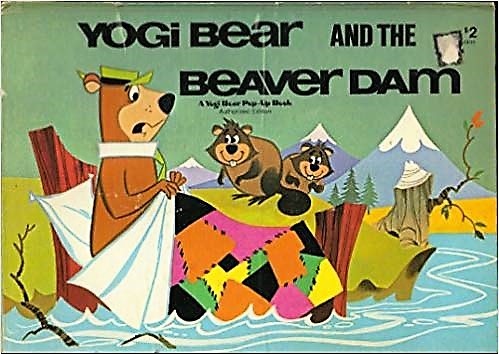Castor Canadensis (American Beaver) Man (Part 3)
Back in the RV, James handled his souvenir. Rain drummed the roof, a real Keith Moon bashing, and James could hardly think. Think! What did those serrated markings on the stick mean? Somewhere…long ago…he’d….learned….about….creatures…that ate wood…and built dams!!!!!!!!
Beavers! Of course! Oregon’s state animal!
James jammed to the library and looked up all the beaver books. They were loaded! Dozens! He pulled them all off the shelves and spread them out on a table.
For the next six hours James read and read and read. The academic tomes touting the hydrological benefits of beavers were as dry as a desert. The children’s books about beavers were easily the best, better written, eccentric, passionate. There was even a pop-up beaver book! Yogi Bear and the Beaver Dam. For the love of castor canadensis! Behold the bucktoothed wonders! James thumbed through the pop-up book for half an hour, giddy at every turn of the page. He particularly loved the lodge and tracing the contours of it with his fingers. He wanted to visit a beaver lodge, but not merely view it from a bank. James wanted to venture inside! To do that, he’d have to swim and submerge underwater. The pop-up book made it look simple.
For the next three months, James collected beaverwood of all shapes and sizes and brought them back to the park. He stacked here and stacked there. He built a makeshift picket fence. He filled a dozen milk crates and three garbage cans.
What was it about beaverwood that so mesmerized James? Why the obsession with beavers? Sure, they were an astonishing animal in many ways, particularly the role their dams played in sculpting the landscape and evolution, but there was more. James tended to look past the science and the history of the near extinction of the species due to the fur trade. There was something in the serrated markings on the wood that spoke to James. When he handled a piece of beaverwood, he held it close, turned it slowly around and around. He felt the markings. A beaver had done an efficient number on a piece of wood, really chewed it up, brought it crashing down to earth.
But there was beauty and originality and purpose in each piece, if anyone cared to notice. Each piece was unique. Each was part subsistence and part shelter. Each was part of a unique supply chain connecting concrete and metaphysical producers. Each was…a piece of art! Beavers were artists! They sculpted with their incisors and didn’t even know they were making art. It was primal. It was instinct. They had no choice but to make art with the material that fed and housed them. Was there anything in nature remotely comparable? Perhaps bees and their secreted honeycombs. Perhaps shells constructed by sea snails that eventually wash up on the beach.
As the beaverwood collection grew it became more of a crude gallery, a gallery curated by one person, a gallery visited by one person. At one point, James wondered if he should stop building his collection. He was getting some strange looks from the other residents of the park.
Do beavers ever stop gnawing? Stop building? Stop making art? Stop the supply chain? Hell No!
Truth be told, James couldn’t stop. And to that, we say Hell Yes!

